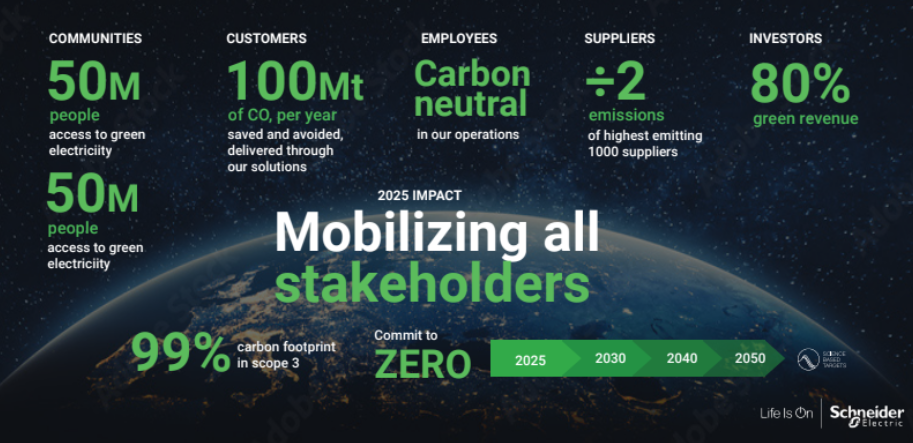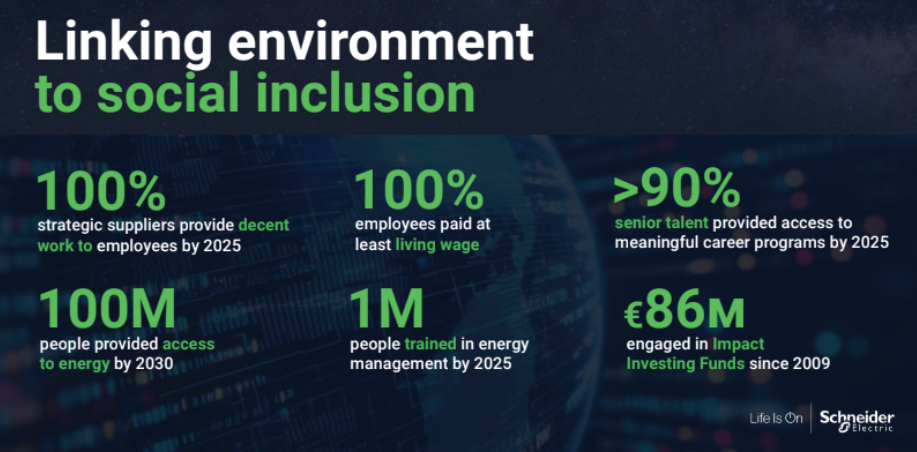Schneider Electric’s Transformation Journey
Start Reading

1. Company at a Glance
In this case study, we will discover how Schneider Electric transformed its business to become a leader in sustainable energy management and digitalization, addressing global challenges such as climate change and energy access. Through technological innovation, strategic collaboration, and a strong focus on sustainability, the company has significantly reduced carbon emissions, improved energy access in underserved communities, and achieved positive economic impact, demonstrating that sustainability and profitability can go hand in hand.
Schneider Electric, a global leader in energy management and automation, has undergone a remarkable transformation over the past two decades. Initially known for manufacturing circuit breakers, the company has evolved into a pioneer in smart and sustainable technologies.
Manufacturing
Industry
1836
Founded
France
Headquarters
+150,000
Number of Employees
The company operates in more than 100 countries
Global Presence
2. The Challenge
Schneider Electric identified two critical and interconnected global challenges
1. Climate Change: The company recognized climate change as the most significant challenge of our generation. The traditional energy model, which heavily relies on carbon-intensive methods, needed to be transformed to reduce emissions. If left unchanged, the trajectory of carbon emissions would exacerbate global warming
2. Energy Access: At the same time, Schneider saw the pressing need to provide energy access to 5 billion people worldwide within the next 20 years. This includes:
- The 1 billion people currently without any access to electricity
- The 2 billion people who will join the global population in the next two decades, mostly in Africa, Asia, and Latin America
- The 2 billion people who have limited energy access and need better solutions to improve their quality of life
These challenges created a tension – how to meet the growing energy demands of billions of people while simultaneously reducing carbon emissions to combat climate change.
3. The Action
To address these challenges, Schneider Electric implemented a comprehensive and multi-faceted transformation strategy:
Redefining the Business
Schneider Electric undertook a bold transformation of its core business. It transitioned from traditional circuit breakers to advanced smart, green, and digitized solutions. This strategic pivot prioritized clean electrification and digital technologies, enabling the company to enhance energy efficiency while significantly reducing carbon emissions. By leveraging digitization, the company achieved energy savings of 30-50% across various sectors, laying the foundation for a greener future.
Focusing on Culture and People
The company invested heavily in fostering a global culture of sustainability. Recognizing that people are at the heart of any transformation, Schneider Electric emphasized collaboration across its diverse workforce in over 100 countries. Sustainability objectives were clearly defined and updated every three years, ensuring relevance and progression. These objectives were embedded into employee incentives, aligning personal and organizational goals. Moreover, Environmental, Social, and Governance (ESG) metrics were integrated into remuneration policies, ensuring that all employees shared accountability for the company’s sustainability journey.
Building a Collaborative Ecosystem
Collaboration became a cornerstone of Schneider Electric’s approach. The company partnered with its top 1,000 suppliers to help them halve their carbon footprints, creating a ripple effect of sustainability throughout its supply chain. Customers were supported in achieving their own net-zero goals through innovative solutions, leading to an annual reduction of 100 million tons of carbon. Schneider Electric also prioritized energy access in emerging markets, bringing green energy to 50 million people and training 1 million individuals in clean electrification and digitization, thereby empowering local communities.
Leadership, Capacity Building, and Operational Execution
To ensure the longevity and effectiveness of its sustainability initiatives, Schneider Electric established a strong governance framework. A Corporate Social Responsibility (CSR) committee was formed at the board level, and an executive was appointed to oversee sustainability strategy. The company collaborated with external stakeholders, including NGOs and political organizations, to continuously refine and challenge its objectives. Independent audits of ESG parameters were conducted alongside financial audits, ensuring transparency and accountability in all aspects of the company’s operations.

4. Impact & Results
Economic Growth
Revenue multiplied by four from FY 2003 (8.8bn Euro) to FY 2024 (38.2bn Euro).
Market capitalization increased by a factor of 11 (2003 market cap was 12bn, by the end of 2024 market cap was 135.2bn).
Recognized as one of the top three companies globally for ESG investments.
Sustainability Achievements
Reduced its own carbon footprint while generating a net-positive carbon impact (100 million tons saved annually vs. a 60-million-ton footprint).
Established leadership in clean energy and energy efficiency technologies.
Garnered global recognition as the world’s most sustainable company in 2021 and again in recent rankings.
Social Contributions
Delivered access to green energy in underserved regions.
Enhanced community resilience through training and capacity-building initiatives.

5. Key Lessons Learned
Sustainability Drives Innovation
Integrating sustainability into core operations stimulates technological advancements and new business opportunities.
People are the Cornerstone
A successful transformation requires investing in people—selecting the right talent, fostering collaboration, and embedding shared values.
Collaboration is Essential
Achieving ESG goals necessitates strong partnerships across the supply chain, customers, and external stakeholders.
Governance and Accountability are Crucial
Transparent and independent governance structures ensure consistent progress toward long-term sustainability goals.
Sustainability and Profitability are Synergistic
Far from being at odds, sustainability enhances economic performance by attracting top talent, securing investor trust, and creating resilient business models.
Schneider Electric’s transformation demonstrates that aligning sustainability with economics is not only possible but also essential for long-term success in today’s global landscape.
"There was a prevailing belief that sustainability and economic performance were mutually exclusive. Schneider Electric sought to prove otherwise by integrating sustainability into its business model without compromising profitability."
Jean-Pascal Tricoire, Chairman
6. Resources
Schneider Electric is an active participant of the United Nations Global Compact since 2013, including:
Carbon pricing champion
Forward Faster signatory in Living Wage and Climate targets
Women's Empowerment Principles (WEPs) signatory
Signatory of Net-Zero commitment
Recommended UN Global Compact resources to support your journey:

E-Learning: Setting Science-Based Targets

E-Learning: The Net-Zero Standard

Climate Ambition Accelerator
Get to know Schneider Electric’s strategy in this conference by Chairman, Jean-Pascal Tricoire.